Biermann Ch. Handbook of Pulping and Papermaking
Подождите немного. Документ загружается.

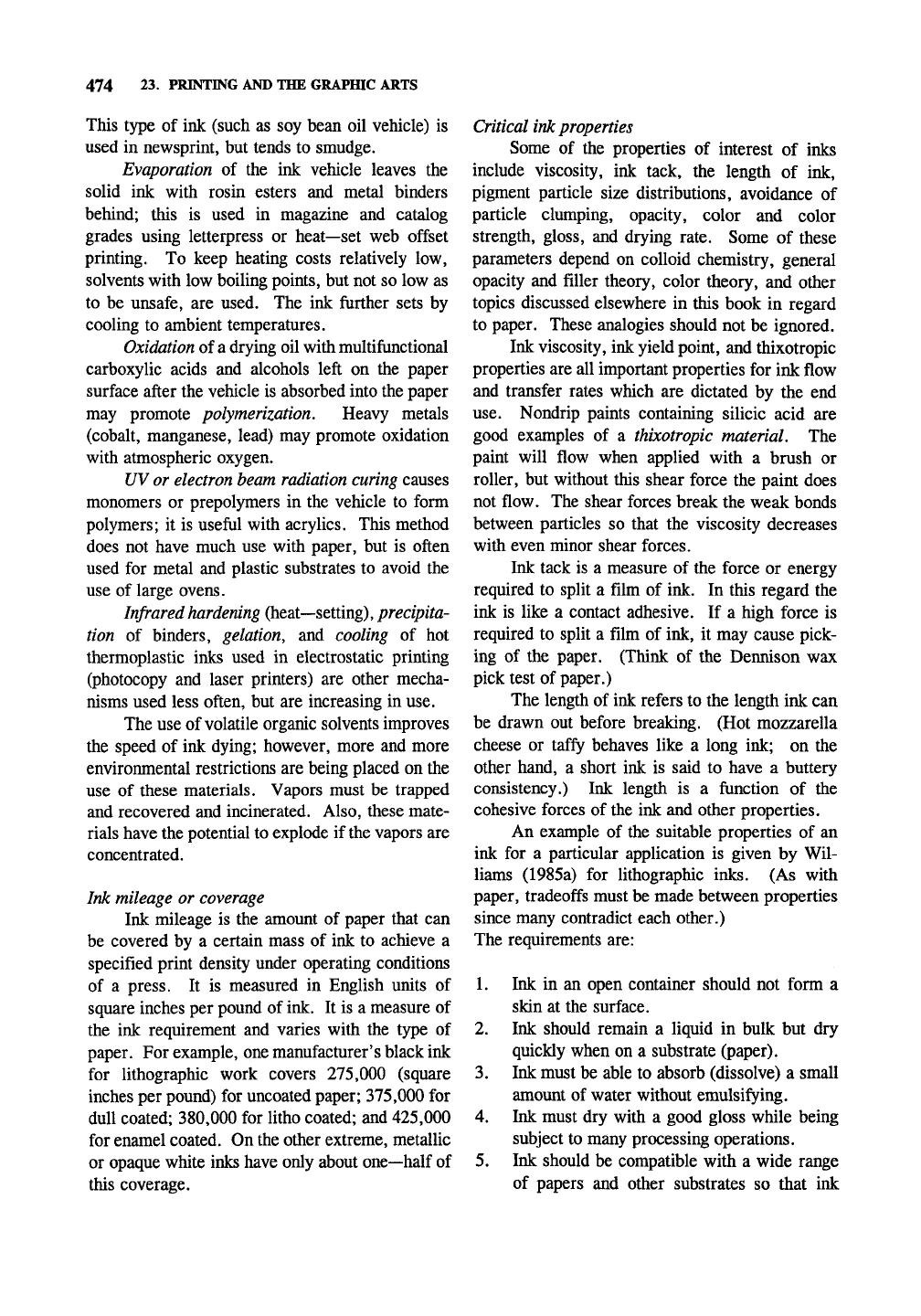
474 23. PRINTING AND THE GRAPHIC ARTS
This type of ink (such as soy bean oil vehicle) is
used in newsprint, but tends to smudge.
Evaporation of the ink vehicle leaves the
solid ink with rosin esters and metal binders
behind; this is used in magazine and catalog
grades using letterpress or heat—set web offset
printing. To keep heating costs relatively low,
solvents with low boiling points, but not so low as
to be unsafe, are used. The ink further sets by
cooling to ambient temperatures.
Oxidation
of
a
drying oil with multifunctional
carboxylic acids and alcohols left on the paper
surface after the vehicle is absorbed into the paper
may promote polymerization. Heavy metals
(cobalt, manganese, lead) may promote oxidation
with atmospheric oxygen.
UV or electron beam radiation curing causes
monomers or prepolymers in the vehicle to form
polymers; it is useful with acrylics. This method
does not have much use with paper, but is often
used for metal and plastic substrates to avoid the
use of large ovens.
Infrared hardening (heat—setting), precipita-
tion of binders, gelation, and cooling of hot
thermoplastic inks used in electrostatic printing
(photocopy and laser printers) are other mecha-
nisms used less often, but are increasing in use.
The use of volatile organic solvents improves
the speed of ink dying; however, more and more
environmental restrictions are being placed on the
use of these materials. Vapors must be trapped
and recovered and incinerated. Also, these mate-
rials have the potential to explode if
the
vapors are
concentrated.
Ink mileage or coverage
Ink mileage is the amount of paper that can
be covered by a certain mass of ink to achieve a
specified print density under operating conditions
of a press. It is measured in English units of
square inches per pound of ink. It is a measure of
the ink requirement and varies with the type of
paper. For example, one manufacturer's black ink
for lithographic work covers 275,000 (square
inches per pound) for uncoated paper; 375,000 for
dull coated; 380,000 for litho coated; and 425,000
for enamel coated. On the other extreme, metallic
or opaque white inks have only about one—half of
this coverage.
Critical
ink
properties
Some of the properties of interest of inks
include viscosity, ink tack, the length of ink,
pigment particle size distributions, avoidance of
particle clumping, opacity, color and color
strength, gloss, and drying rate. Some of these
parameters depend on colloid chemistry, general
opacity and filler theory, color theory, and other
topics discussed elsewhere in this book in regard
to paper. These analogies should not be ignored.
Ink viscosity, ink yield point, and thixotropic
properties are all important properties for ink flow
and transfer rates which are dictated by the end
use.
Nondrip paints containing silicic acid are
good examples of a thixotropic material. The
paint will flow when applied with a brush or
roller, but without this shear force the paint does
not flow. The shear forces break the weak bonds
between particles so that the viscosity decreases
with even minor shear forces.
Ink tack is a measure of the force or energy
required to split a film of ink. In this regard the
ink is like a contact adhesive. If a high force is
required to split a film of ink, it may cause pick-
ing of the paper. (Think of the Dennison wax
pick test of paper.)
The length of ink refers to the length ink can
be drawn out before breaking. (Hot mozzarella
cheese or taffy behaves like a long ink; on the
other hand, a short ink is said to have a buttery
consistency.) Ink length is a function of the
cohesive forces of the ink and other properties.
An example of the suitable properties of an
ink for a particular application is given by Wil-
liams (1985a) for lithographic inks. (As with
paper, tradeoffs must be made between properties
since many contradict each other.)
The requirements are:
1.
Ink in an open container should not form a
skin at the surface.
2.
Ink should remain a liquid in bulk but dry
quickly when on a substrate (paper).
3.
Ink must be able to absorb (dissolve) a small
amount of water without emulsifying.
4.
Ink must dry with a good gloss while being
subject to many processing operations.
5.
Ink should be compatible with a wide range
of papers and other substrates so that ink
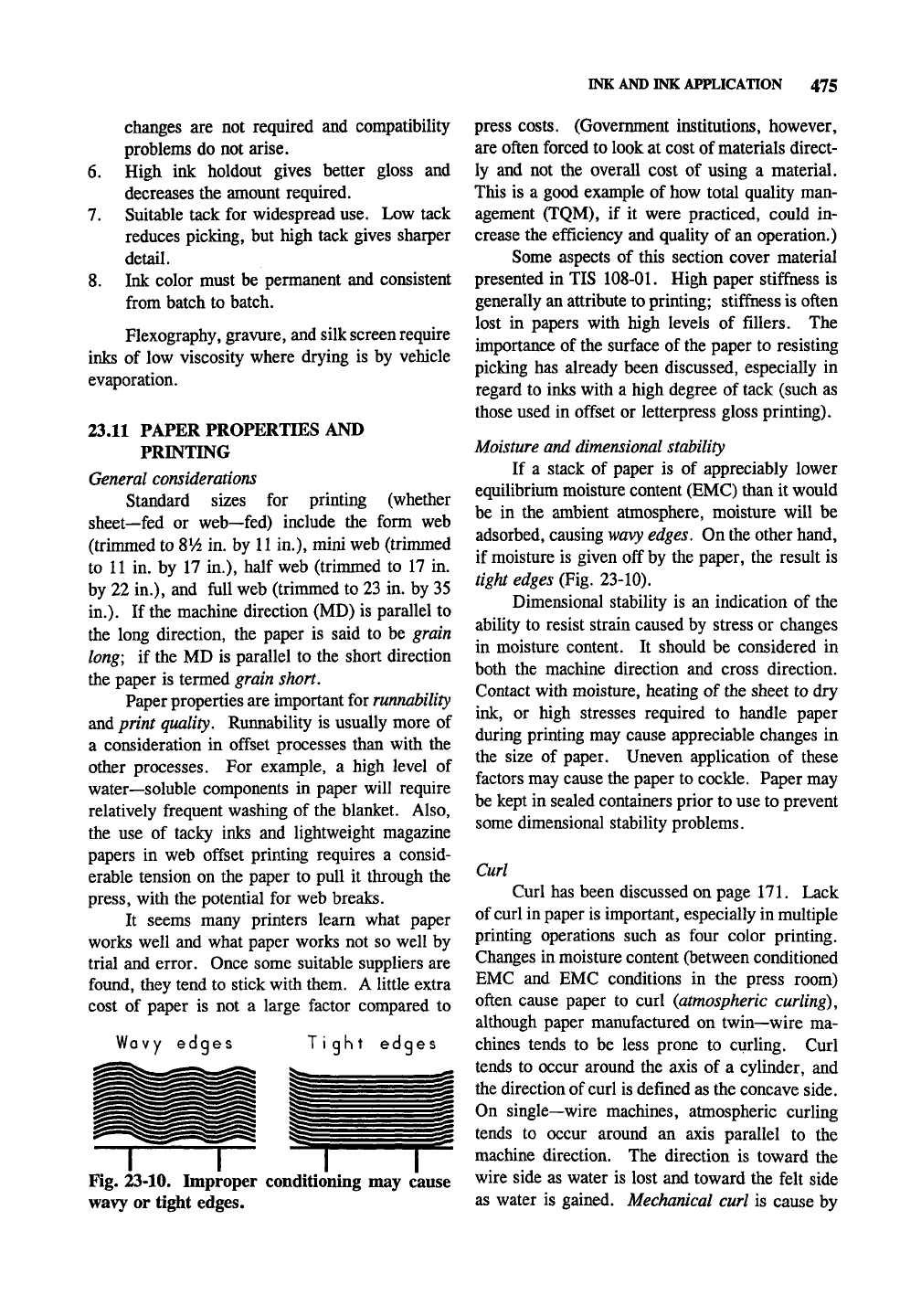
INK AND INK APPLICATION 475
changes are not required and compatibility
problems do not arise.
6. High ink holdout gives better gloss and
decreases the amount required.
7.
Suitable tack for widespread use. Low tack
reduces picking, but high tack gives sharper
detail.
8. Ink color must be permanent and consistent
from batch to batch.
Flexography, gravure, and silk screen require
inks of low viscosity where drying is by vehicle
evaporation.
23.11 PAPER PROPERTIES AND
PRINTING
General considerations
Standard sizes for printing (whether
sheet—fed or web—fed) include the form web
(trimmed to
8V2
in. by 11 in.), mini web (trimmed
to 11 in. by 17 in.), half web (trimmed to 17 in.
by 22 in.), and full web (trimmed to 23 in. by 35
in.).
If the machine direction (MD) is parallel to
the long direction, the paper is said to be grain
long; if the MD is parallel to the short direction
the paper is termed grain short.
Paper properties are important for
runnability
and print quality. Runnability is usually more of
a consideration in offset processes than with the
other processes. For example, a high level of
water—soluble components in paper will require
relatively frequent washing of the blanket. Also,
the use of tacky inks and lightweight magazine
papers in web offset printing requires a consid-
erable tension on the paper to pull it through the
press,
with the potential for web breaks.
It seems many printers learn what paper
works well and what paper works not so well by
trial and error. Once some suitable suppliers are
found, they tend to stick with them. A little extra
cost of paper is not a large factor compared to
jht
les
T
Fig. 23-10. Improper conditioning may cause
wavy or tight edges.
press costs. (Government institutions, however,
are often forced to look at cost of materials direct-
ly and not the overall cost of using a material.
This is a good example of how total quality man-
agement (TQM), if it were practiced, could in-
crease the efficiency and quality of an operation.)
Some aspects of this section cover material
presented in TIS
108-01.
High paper stiffness is
generally an attribute to printing; stiffness is often
lost in papers with high levels of fillers. The
importance of the surface of the paper to resisting
picking has already been discussed, especially in
regard to inks with a high degree of tack (such as
those used in offset or letterpress gloss printing).
Moisture and dimensional stability
If a stack of paper is of appreciably lower
equilibrium moisture content (EMC) than it would
be in the ambient atmosphere, moisture will be
adsorbed, causing
wavy
edges. On the other hand,
if moisture is given off by the paper, the result is
tight edges (Fig. 23-10).
Dimensional stability is an indication of the
ability to resist strain caused by stress or changes
in moisture content. It should be considered in
both the machine direction and cross direction.
Contact with moisture, heating of the sheet to dry
ink, or high stresses required to handle paper
during printing may cause appreciable changes in
the size of paper. Uneven application of these
factors may cause the paper to cockle. Paper may
be kept in sealed containers prior to use to prevent
some dimensional stability problems.
Curl
Curl has been discussed on page 171. Lack
of curl in paper is important, especially in multiple
printing operations such as four color printing.
Changes in moisture content (between conditioned
EMC and EMC conditions in the press room)
often cause paper to curl {atmospheric curling),
although paper manufactured on twin—wire ma-
chines tends to be less prone to curling. Curl
tends to occur around the axis of a cylinder, and
the direction of curl is defined as the concave side.
On single—wire machines, atmospheric curling
tends to occur around an axis parallel to the
machine direction. The direction is toward the
wire side as water is lost and toward the felt side
as water is gained. Mechanical curl is cause by
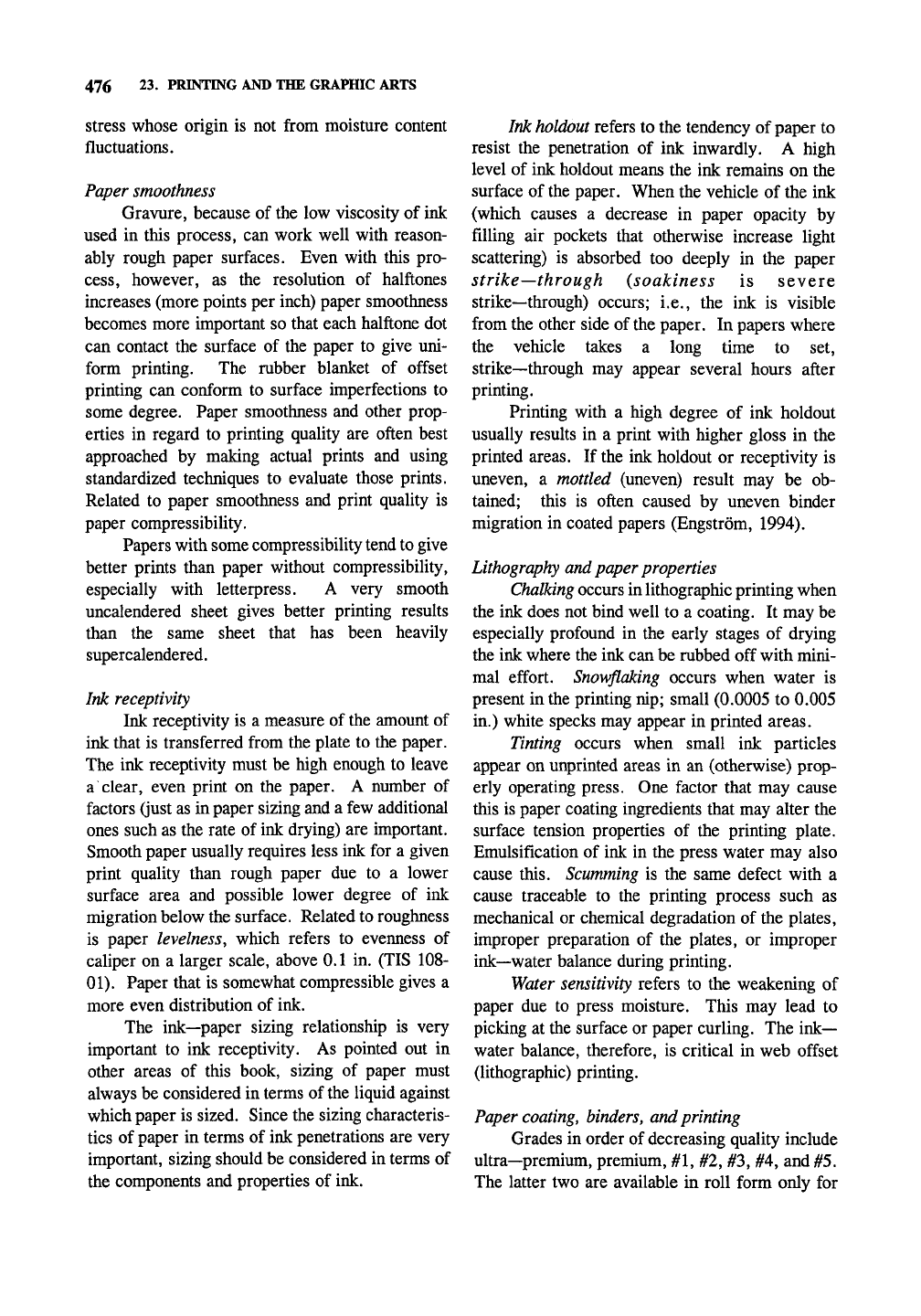
476 23. PRINTING AND THE GRAPHIC ARTS
Stress whose origin is not from moisture content
fluctuations.
Paper smoothness
Gravure, because of the low viscosity of ink
used in this process, can work well with reason-
ably rough paper surfaces. Even with this pro-
cess,
however, as the resolution of halftones
increases (more points per inch) paper smoothness
becomes more important so that each halftone dot
can contact the surface of the paper to give uni-
form printing. The rubber blanket of offset
printing can conform to surface imperfections to
some degree. Paper smoothness and other prop-
erties in regard to printing quality are often best
approached by making actual prints and using
standardized techniques to evaluate those prints.
Related to paper smoothness and print quality is
paper compressibility.
Papers with some compressibility tend to give
better prints than paper without compressibility,
especially with letterpress. A very smooth
uncalendered sheet gives better printing results
than the same sheet that has been heavily
supercalendered.
Ink receptivity
Ink receptivity is a measure of the amount of
ink that is transferred from the plate to the paper.
The ink receptivity must be high enough to leave
a clear, even print on the paper. A number of
factors (just as in paper sizing and a few additional
ones such as the rate of ink drying) are important.
Smooth paper usually requires less ink for a given
print quality than rough paper due to a lower
surface area and possible lower degree of ink
migration below the surface. Related to roughness
is paper levelness, which refers to evenness of
caliper on a larger scale, above 0.1 in. (TIS 108-
01).
Paper that is somewhat compressible gives a
more even distribution of ink.
The ink—paper sizing relationship is very
important to ink receptivity. As pointed out in
other areas of this book, sizing of paper must
always be considered in terms of
the
liquid against
which paper is sized. Since the sizing characteris-
tics of paper in terms of ink penetrations are very
important, sizing should be considered in terms of
the components and properties of ink.
Ink holdout refers to the tendency of paper to
resist the penetration of ink inwardly. A high
level of ink holdout means the ink remains on the
surface of the paper. When the vehicle of the ink
(which causes a decrease in paper opacity by
filling air pockets that otherwise increase light
scattering) is absorbed too deeply in the paper
strike—through (soakiness is severe
strike—through) occurs; i.e., the ink is visible
from the other side of the paper. In papers where
the vehicle takes a long time to set,
strike—through may appear several hours after
printing.
Printing with a high degree of ink holdout
usually results in a print with higher gloss in the
printed areas. If the ink holdout or receptivity is
uneven, a mottled (uneven) result may be ob-
tained; this is often caused by uneven binder
migration in coated papers (Engstrom, 1994).
Lithography
and
paper properties
Chalking
occurs in lithographic printing when
the ink does not bind well to a coating. It may be
especially profound in the early stages of drying
the ink where the ink can be rubbed off with mini-
mal effort. Snowflaking occurs when water is
present in the printing nip; small (0.0005 to 0.005
in.) white specks may appear in printed areas.
Tinting occurs when small ink particles
appear on unprinted areas in an (otherwise) prop-
erly operating press. One factor that may cause
this is paper coating ingredients that may alter the
surface tension properties of the printing plate.
Emulsification of ink in the press water may also
cause this. Scumming is the same defect with a
cause traceable to the printing process such as
mechanical or chemical degradation of the plates,
improper preparation of the plates, or improper
ink—water balance during printing.
Water sensitivity refers to the weakening of
paper due to press moisture. This may lead to
picking at the surface or paper curling. The ink-
water balance, therefore, is critical in web offset
(lithographic) printing.
Paper
coating,
binders, and printing
Grades in order of decreasing quality include
ultra—premium, premium, #1, #2, #3, #4, and #5.
The latter two are available in roll form only for
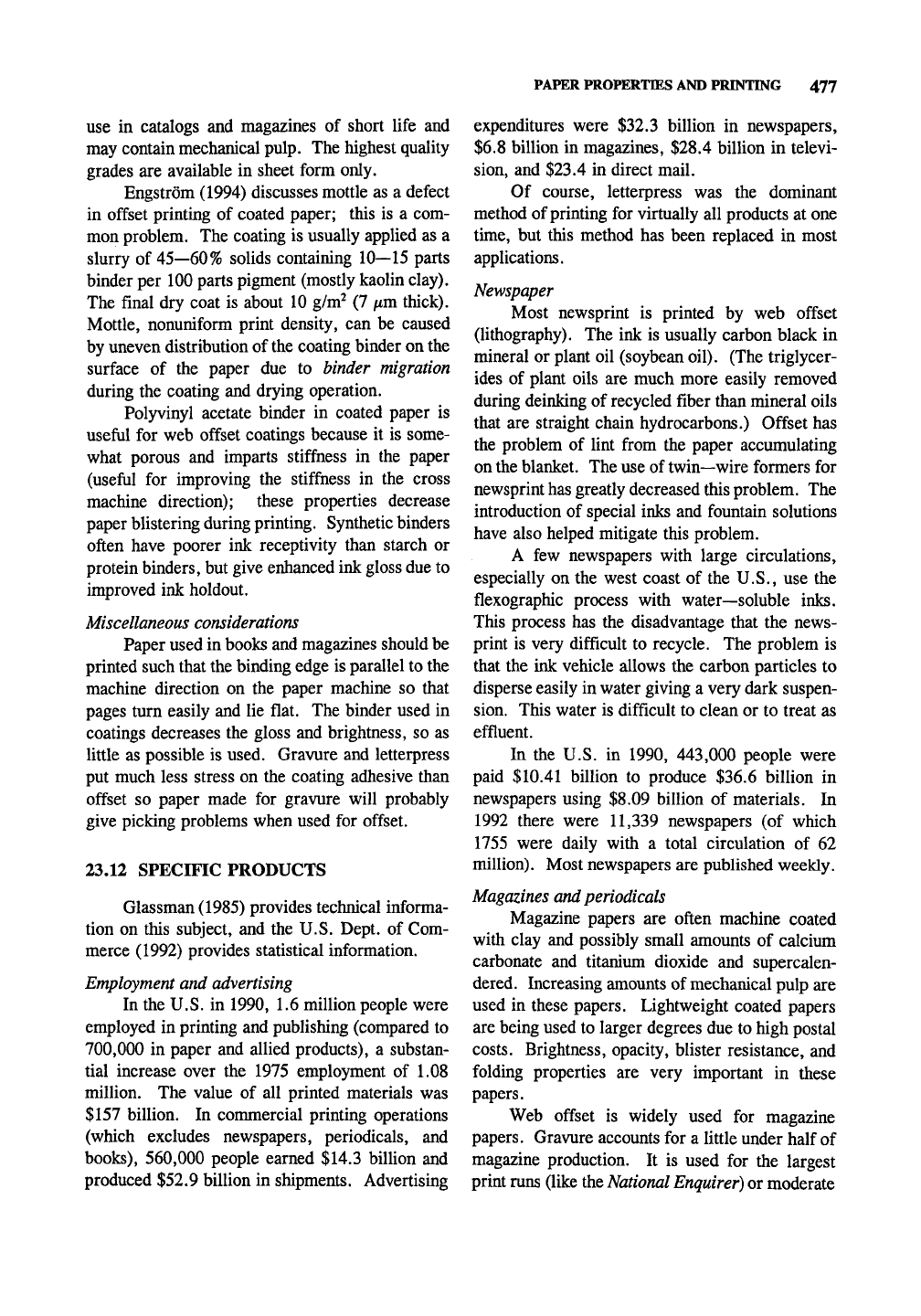
PAPER PROPERTIES AND PRINTING 477
use in catalogs and magazines of short life and
may contain mechanical pulp. The highest quality
grades are available in sheet form only.
Engstrom (1994) discusses mottle as a defect
in offset printing of coated paper; this is a com-
mon problem. The coating is usually applied as a
slurry of 45—60% solids containing 10—15 parts
binder per 100 parts pigment (mostly kaolin clay).
The final dry coat is about 10
give?
(7 /xm thick).
Mottle, nonuniform print density, can be caused
by uneven distribution of
the
coating binder on the
surface of the paper due to binder migration
during the coating and drying operation.
Polyvinyl acetate binder in coated paper is
useful for web offset coatings because it is some-
what porous and imparts stiffness in the paper
(useful for improving the stiffness in the cross
machine direction); these properties decrease
paper blistering during printing. Synthetic binders
often have poorer ink receptivity than starch or
protein binders, but give enhanced ink gloss due to
improved ink holdout.
Miscellaneous considerations
Paper used in books and magazines should be
printed such that the binding edge is parallel to the
machine direction on the paper machine so that
pages turn easily and lie flat. The binder used in
coatings decreases the gloss and brightness, so as
little as possible is used. Gravure and letterpress
put much less stress on the coating adhesive than
offset so paper made for gravure will probably
give picking problems when used for offset.
23.12 SPECIFIC PRODUCTS
Glassman(1985) provides technical informa-
tion on this subject, and the U.S. Dept. of Com-
merce (1992) provides statistical information.
Employment and advertising
In the U.S. in 1990, 1.6 million people were
employed in printing and publishing (compared to
700,000 in paper and allied products), a substan-
tial increase over the 1975 employment of 1.08
million. The value of all printed materials was
$157 billion. In commercial printing operations
(which excludes newspapers, periodicals, and
books),
560,000 people earned $14.3 bilUon and
produced $52.9 billion in shipments. Advertising
expenditures were $32.3 billion in newspapers,
$6.8 billion in magazines, $28.4 billion in televi-
sion, and $23.4 in direct mail.
Of course, letterpress was the dominant
method of printing for virtually all products at one
time,
but this method has been replaced in most
applications.
Newspaper
Most newsprint is printed by web offset
(lithography). The ink is usually carbon black in
mineral or plant oil (soybean oil). (The triglycer-
ides of plant oils are much more easily removed
during deinking of recycled fiber than mineral oils
that are straight chain hydrocarbons.) Offset has
the problem of lint from the paper accumulating
on the blanket. The use of twin—wire formers for
newsprint has greatly decreased this problem. The
introduction of special inks and fountain solutions
have also helped mitigate this problem.
A few newspapers with large circulations,
especially on the west coast of the U.S., use the
flexographic process with water—soluble inks.
This process has the disadvantage that the news-
print is very difficult to recycle. The problem is
that the ink vehicle allows the carbon particles to
disperse easily in water giving a very dark suspen-
sion. This water is difficult to clean or to treat as
effluent.
In the U.S. in 1990, 443,000 people were
paid $10.41 billion to produce $36.6 billion in
newspapers using $8.09 billion of materials. In
1992 there were 11,339 newspapers (of which
1755 were daily with a total circulation of 62
million). Most newspapers are published weekly.
Magazines and periodicals
Magazine papers are often machine coated
with clay and possibly small amounts of calcium
carbonate and titanium dioxide and supercalen-
dered. Increasing amounts of mechanical pulp are
used in these papers. Lightweight coated papers
are being used to larger degrees due to high postal
costs.
Brightness, opacity, blister resistance, and
folding properties are very important in these
papers.
Web offset is widely used for magazine
papers. Gravure accounts for a little under half of
magazine production. It is used for the largest
print runs (like the National Enquirer) or moderate
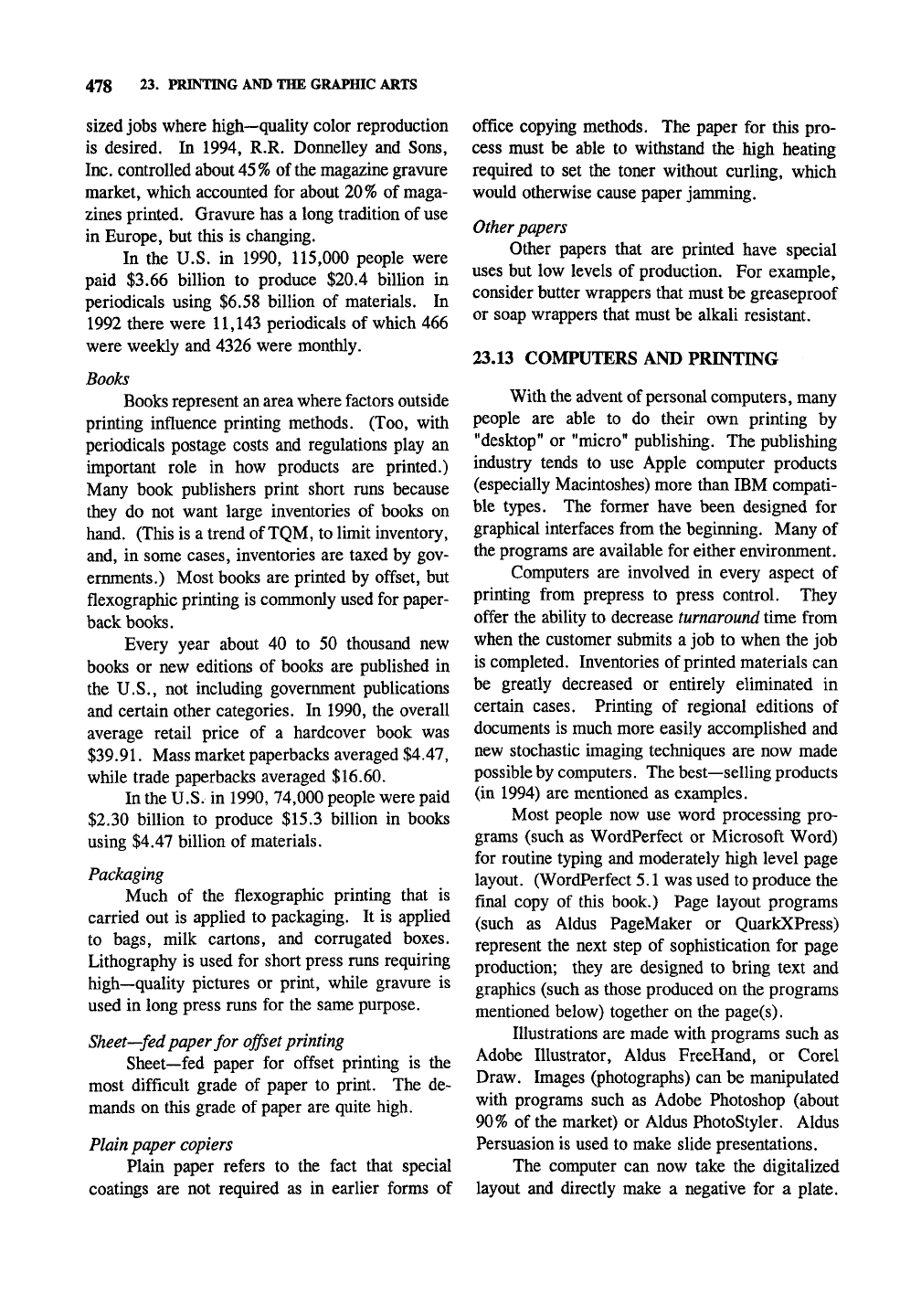
478
23.
PRINTING AND THE GRAPHIC ARTS
sized jobs where high—quality color reproduction
is desired. In 1994, R.R. Donnelley and Sons,
Inc.
controlled about
45%
of the magazine gravure
market, which accounted for about 20% of maga-
zines printed. Gravure has a long tradition of use
in Europe, but this is changing.
In the U.S. in 1990, 115,000 people were
paid $3.66 billion to produce $20.4 billion in
periodicals using $6.58 billion of materials. In
1992 there were 11,143 periodicals of which 466
were weekly and 4326 were monthly.
Books
Books represent an area where factors outside
printing influence printing methods. (Too, with
periodicals postage costs and regulations play an
important role in how products are printed.)
Many book publishers print short runs because
they do not want large inventories of books on
hand. (This is a trend of
TQM,
to limit inventory,
and, in some cases, inventories are taxed by gov-
ernments.) Most books are printed by offset, but
flexographic printing is commonly used for paper-
back books.
Every year about 40 to 50 thousand new
books or new editions of books are published in
the U.S., not including government publications
and certain other categories. In 1990, the overall
average retail price of a hardcover book was
$39.91.
Mass market paperbacks averaged $4.47,
while trade paperbacks averaged $16.60.
In the U.S. in 1990, 74,000 people were paid
$2.30 billion to produce $15.3 billion in books
using $4.47 billion of materials.
Packaging
Much of the flexographic printing that is
carried out is applied to packaging. It is applied
to bags, milk cartons, and corrugated boxes.
Lithography is used for short press runs requiring
high—quality pictures or print, while gravure is
used in long press runs for the same purpose.
Sheet—fed paper for offset printing
Sheet—fed paper for offset printing is the
most difficult grade of paper to print. The de-
mands on this grade of paper are quite high.
Plain paper copiers
Plain paper refers to the fact that special
coatings are not required as in earlier forms of
office copying methods. The paper for this pro-
cess must be able to withstand the high heating
required to set the toner without curling, which
would otherwise cause paper jamming.
Other papers
Other papers that are printed have special
uses but low levels of production. For example,
consider butter wrappers that must be greaseproof
or soap wrappers that must be alkali resistant.
23.13 COMPUTERS AND PRINTING
With the advent of personal computers, many
people are able to do their own printing by
"desktop" or "micro" publishing. The publishing
industry tends to use Apple computer products
(especially Macintoshes) more than IBM compati-
ble types. The former have been designed for
graphical interfaces from the beginning. Many of
the programs are available for either environment.
Computers are involved in every aspect of
printing from prepress to press control. They
offer the ability to decrease turnaround time from
when the customer submits a job to when the job
is completed. Inventories of printed materials can
be greatly decreased or entirely eliminated in
certain cases. Printing of regional editions of
documents is much more easily accomplished and
new stochastic imaging techniques are now made
possible by computers. The best—selling products
(in 1994) are mentioned as examples.
Most people now use word processing pro-
grams (such as WordPerfect or Microsoft Word)
for routine typing and moderately high level page
layout. (WordPerfect 5.1 was used to produce the
final copy of this book.) Page layout programs
(such as Aldus PageMaker or QuarkXPress)
represent the next step of sophistication for page
production; they are designed to bring text and
graphics (such as those produced on the programs
mentioned below) together on the page(s).
Illustrations are made with programs such as
Adobe Illustrator, Aldus FreeHand, or Corel
Draw. Images (photographs) can be manipulated
with programs such as Adobe Photoshop (about
90%
of the market) or Aldus PhotoStyler. Aldus
Persuasion is used to make slide presentations.
The computer can now take the digitalized
layout and directly make a negative for a plate.
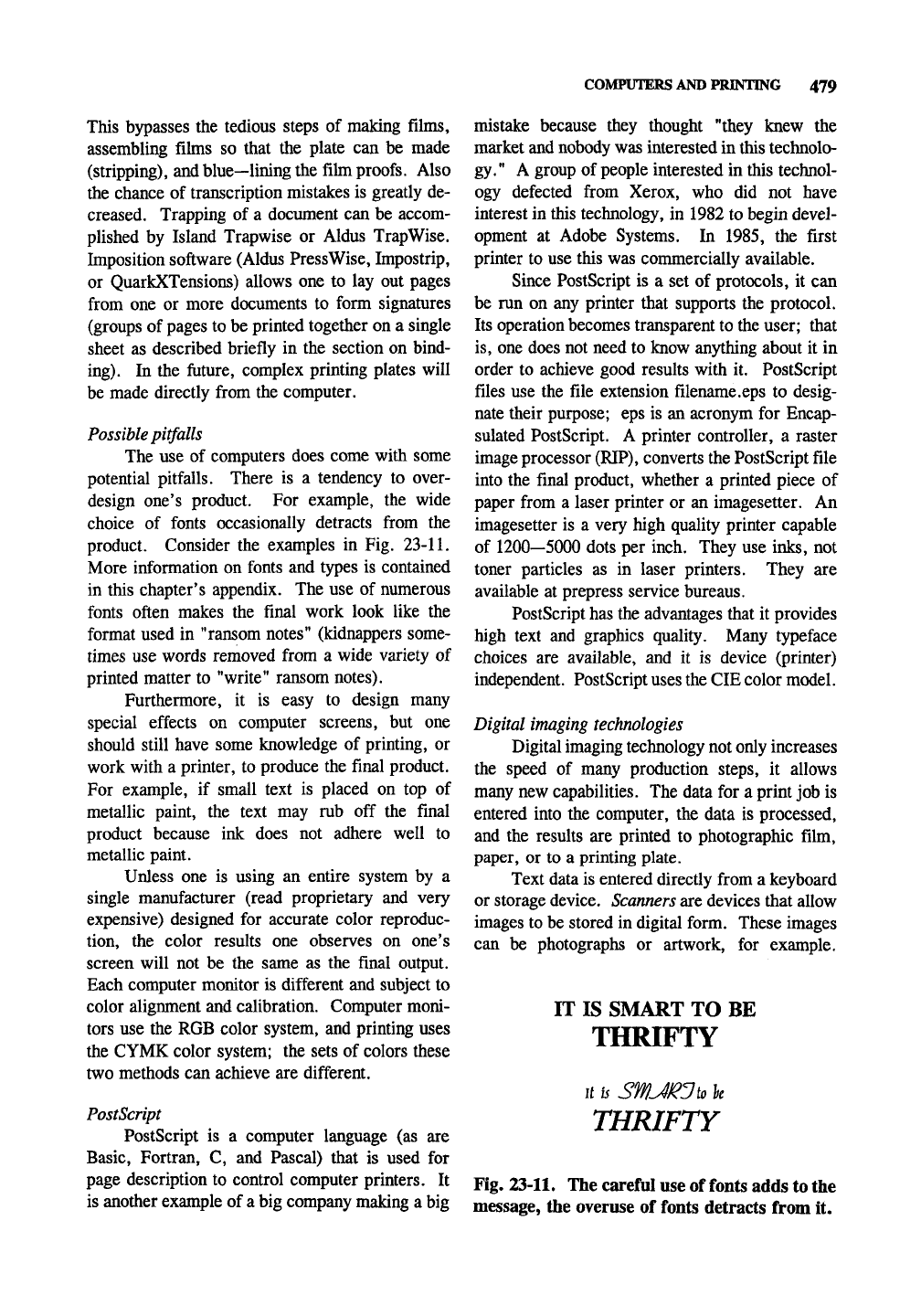
COMPUTERS AND PRINTING 479
This bypasses the tedious steps of making films,
assembling films so that the plate can be made
(stripping), and blue—lining the film proofs. Also
the chance of transcription mistakes is greatly de-
creased. Trapping of a document can be accom-
plished by Island Trapwise or Aldus TrapWise.
Imposition software (Aldus PressWise, Impostrip,
or QuarkXTensions) allows one to lay out pages
from one or more documents to form signatures
(groups of pages to be printed together on a single
sheet as described briefly in the section on bind-
ing).
In the fixture, complex printing plates will
be made directly from the computer.
Possible pitfalls
The use of computers does come with some
potential pitfalls. There is a tendency to over-
design one's product. For example, the wide
choice of fonts occasionally detracts from the
product. Consider the examples in Fig.
23-11.
More information on fonts and types is contained
in this chapter's appendix. The use of numerous
fonts often makes the final work look like the
format used in "ransom notes" (kidnappers some-
times use words removed from a wide variety of
printed matter to "write" ransom notes).
Furthermore, it is easy to design many
special effects on computer screens, but one
should still have some knowledge of printing, or
work with a printer, to produce the final product.
For example, if small text is placed on top of
metallic paint, the text may rub off the final
product because ink does not adhere well to
metallic paint.
Unless one is using an entire system by a
single manufacturer (read proprietary and very
expensive) designed for accurate color reproduc-
tion, the color results one observes on one's
screen will not be the same as the final output.
Each computer monitor is different and subject to
color alignment and calibration. Computer moni-
tors use the RGB color system, and printing uses
the CYMK color system; the sets of colors these
two methods can achieve are different.
PostScript
PostScript is a computer language (as are
Basic, Fortran, C, and Pascal) that is used for
page description to control computer printers. It
is another example of a big company making a big
mistake because they thought "they knew the
market and nobody was interested in this technolo-
gy." A group of people interested in this technol-
ogy defected from Xerox, who did not have
interest in this technology, in 1982 to begin devel-
opment at Adobe Systems. In 1985, the first
printer to use this was commercially available.
Since PostScript is a set of protocols, it can
be run on any printer that supports the protocol.
Its operation becomes transparent to the user; that
is,
one does not need to know anything about it in
order to achieve good results with it. PostScript
files use the file extension filename.eps to desig-
nate their purpose; eps is an acronym for Encap-
sulated PostScript. A printer controller, a raster
image processor (RIP), converts the PostScript file
into the final product, whether a printed piece of
paper from a laser printer or an imagesetter. An
imagesetter is a very high quality printer capable
of 1200—5000 dots per inch. They use inks, not
toner particles as in laser printers. They are
available at prepress service bureaus.
PostScript has the advantages that it provides
high text and graphics quality. Many typeface
choices are available, and it is device (printer)
independent. PostScript uses the CIE color model.
Digital imaging technologies
Digital imaging technology not only increases
the speed of many production steps, it allows
many new capabilities. The data for a print job is
entered into the computer, the data is processed,
and the results are printed to photographic film,
paper, or to a printing plate.
Text data is entered directly from a keyboard
or storage device.
Scanners
are devices that allow
images to be stored in digital form. These images
can be photographs or artwork, for example.
IT IS SMART TO BE
THRIFTY
THRIFTY
Fig.
23-11.
The careful use of fonts adds to the
message, the overuse of fonts detracts from it.
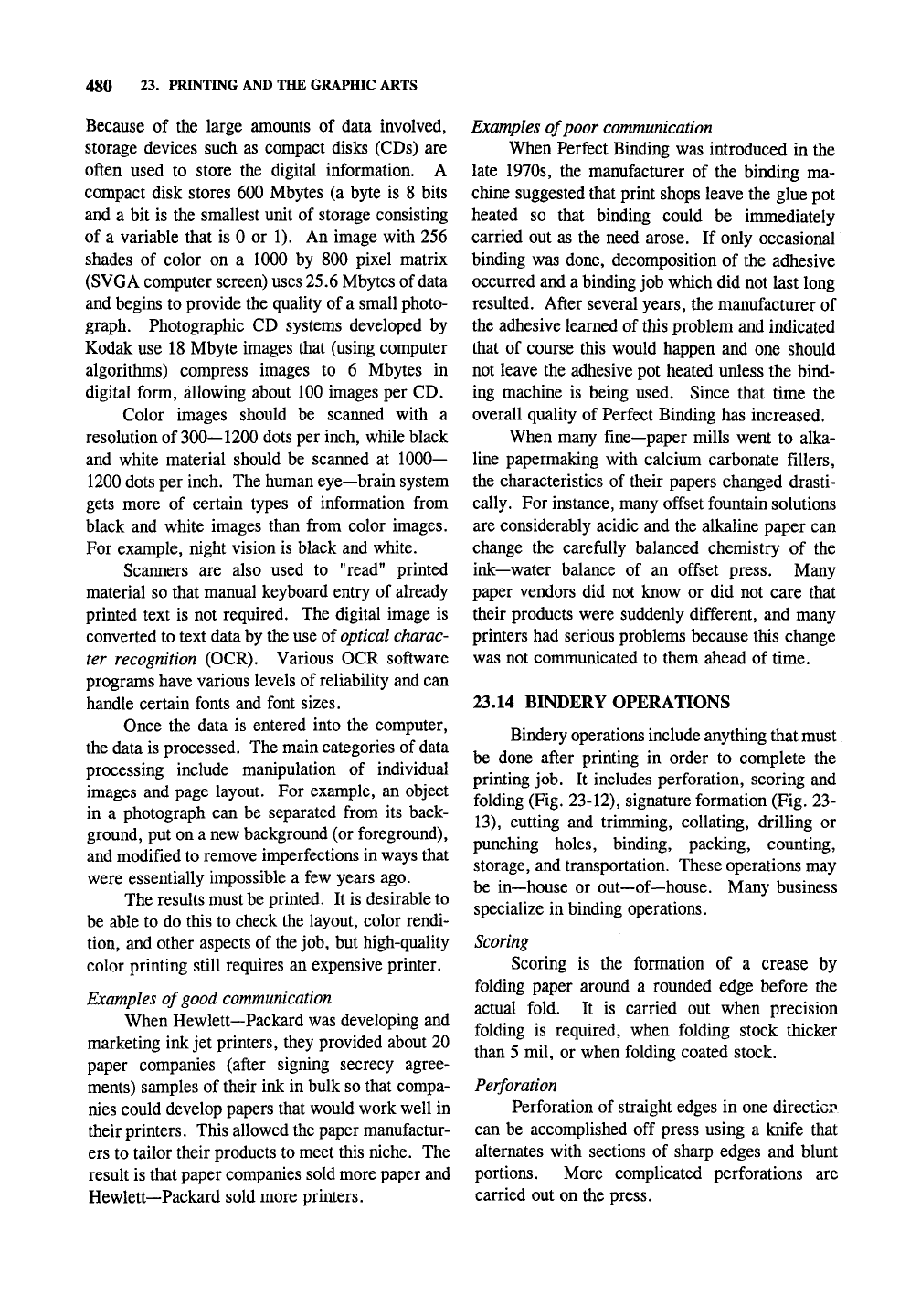
480 23. PRINTING AND THE GRAPHIC ARTS
Because of the large amounts of data involved,
storage devices such as compact disks (CDs) are
often used to store the digital information. A
compact disk stores 600 Mbytes (a byte is 8 bits
and a bit is the smallest unit of storage consisting
of a variable that is 0 or 1). An image with 256
shades of color on a 1000 by 800 pixel matrix
(SVGA computer screen) uses 25.6 Mbytes of data
and begins to provide the quality of a small photo-
graph. Photographic CD systems developed by
Kodak use 18 Mbyte images that (using computer
algorithms) compress images to 6 Mbytes in
digital form, allowing about 100 images per CD.
Color images should be scanned with a
resolution of 300—1200 dots per inch, while black
and white material should be scanned at 1000—
1200 dots per inch. The human eye—brain system
gets more of certain types of information from
black and white images than from color images.
For example, night vision is black and white.
Scanners are also used to "read" printed
material so that manual keyboard entry of already
printed text is not required. The digital image is
converted to text data by the use of
optical
charac-
ter recognition (OCR). Various OCR software
programs have various levels of reliability and can
handle certain fonts and font sizes.
Once the data is entered into the computer,
the data is processed. The main categories of data
processing include manipulation of individual
images and page layout. For example, an object
in a photograph can be separated from its back-
ground, put on a new background (or foreground),
and modified to remove imperfections in ways that
were essentially impossible a few years ago.
The results must be printed. It is desirable to
be able to do this to check the layout, color rendi-
tion, and other aspects of the job, but high-quality
color printing still requires an expensive printer.
Examples of good
communication
When Hewlett—Packard was developing and
marketing Inkjet printers, they provided about 20
paper companies (after signing secrecy agree-
ments) samples of their ink in bulk so that compa-
nies could develop papers that would work well in
their printers. This allowed the paper manufactur-
ers to tailor their products to meet this niche. The
result is that paper companies sold more paper and
Hewlett—Packard sold more printers.
Examples of poor
communication
When Perfect Binding was introduced in the
late 1970s, the manufacturer of the binding ma-
chine suggested that print shops leave the glue pot
heated so that binding could be immediately
carried out as the need arose. If only occasional
binding was done, decomposition of the adhesive
occurred and a binding job which did not last long
resulted. After several years, the manufacturer of
the adhesive learned of this problem and indicated
that of course this would happen and one should
not leave the adhesive pot heated unless the bind-
ing machine is being used. Since that time the
overall quality of Perfect Binding has increased.
When many fine—paper mills went to alka-
line papermaking with calcium carbonate fillers,
the characteristics of their papers changed drasti-
cally. For instance, many offset fountain solutions
are considerably acidic and the alkaline paper can
change the carefully balanced chemistry of the
ink—water balance of an offset press. Many
paper vendors did not know or did not care that
their products were suddenly different, and many
printers had serious problems because this change
was not communicated to them ahead of time.
23.14 BEWERY OPERATIONS
Bindery operations include anything that must
be done after printing in order to complete the
printing job. It includes perforation, scoring and
folding (Fig. 23-12), signature formation (Fig. 23-
13),
cutting and trimming, collating, drilling or
punching holes, binding, packing, counting,
storage, and transportation. These operations may
be in—house or out—of—house. Many business
specialize in binding operations.
Scoring
Scoring is the formation of a crease by
folding paper around a rounded edge before the
actual fold. It is carried out when precision
folding is required, when folding stock thicker
than 5 mil, or when folding coated stock.
Perforation
Perforation of straight edges in one direction
can be accomplished off press using a knife that
alternates with sections of sharp edges and blunt
portions. More complicated perforations are
carried out on the press.
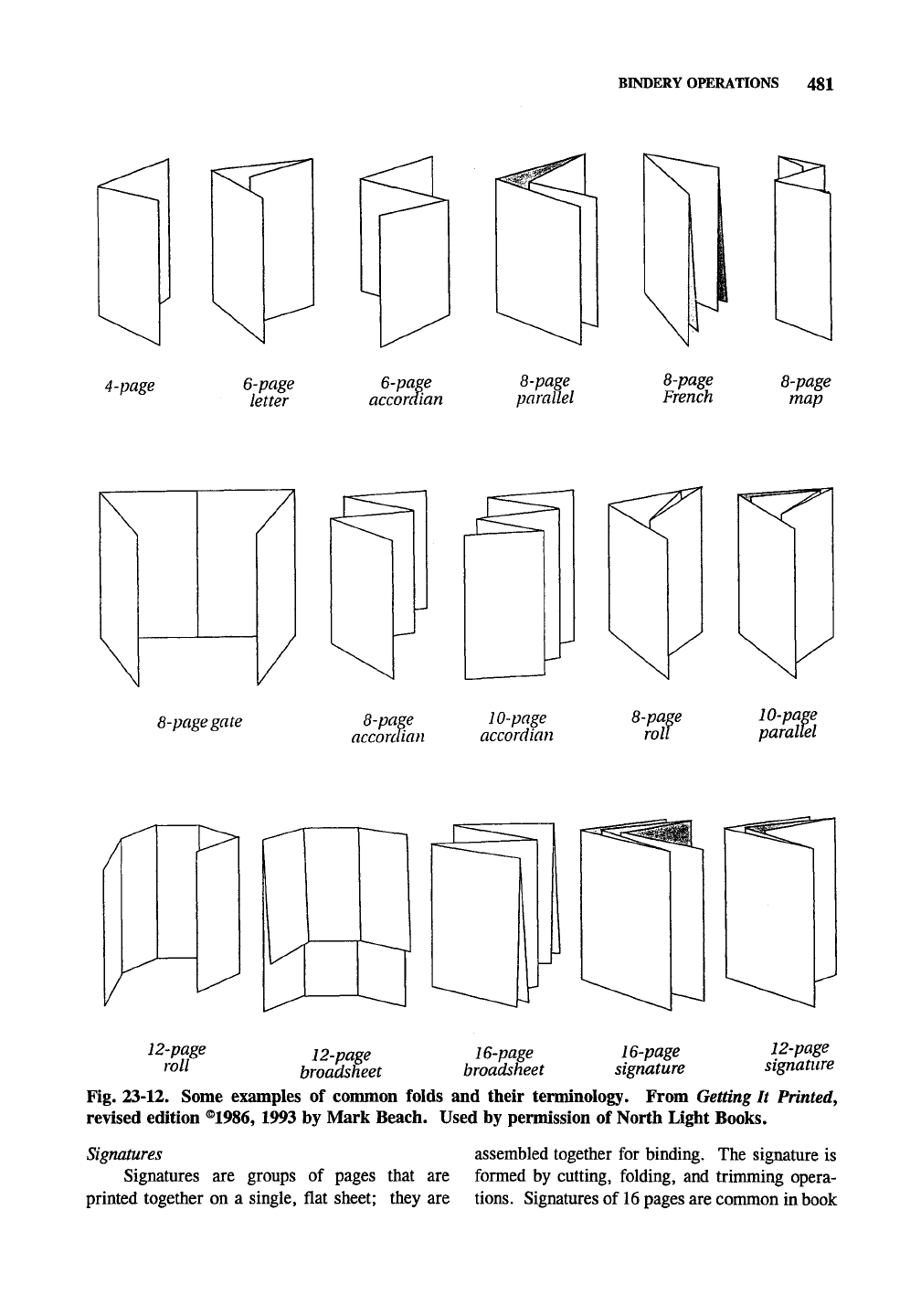
BINDERY OPERATIONS 481
4-page
6-page
letter
6-page
accoraian
8-page
parallel
8-page
French
8-page
map
8-page
gate
8-page
accoraian
10-page
accordian
8-page
roll
10-page
parallel
V
12-page
roll
12-page
broadsheet
16-page
broadsheet
16-page
signature
12'page
signature
Fig. 23-12. Some examples of common folds and their terminology. From Getting It
Printed^
revised edition ®1986, 1993 by Mark Beach. Used by permission of North Light Books.
Signatures
Signatures are groups of pages that are
printed together on a single, flat sheet; they are
assembled together for binding. The signature is
formed by cutting, folding, and trimming opera-
tions.
Signatures of 16 pages are common in book
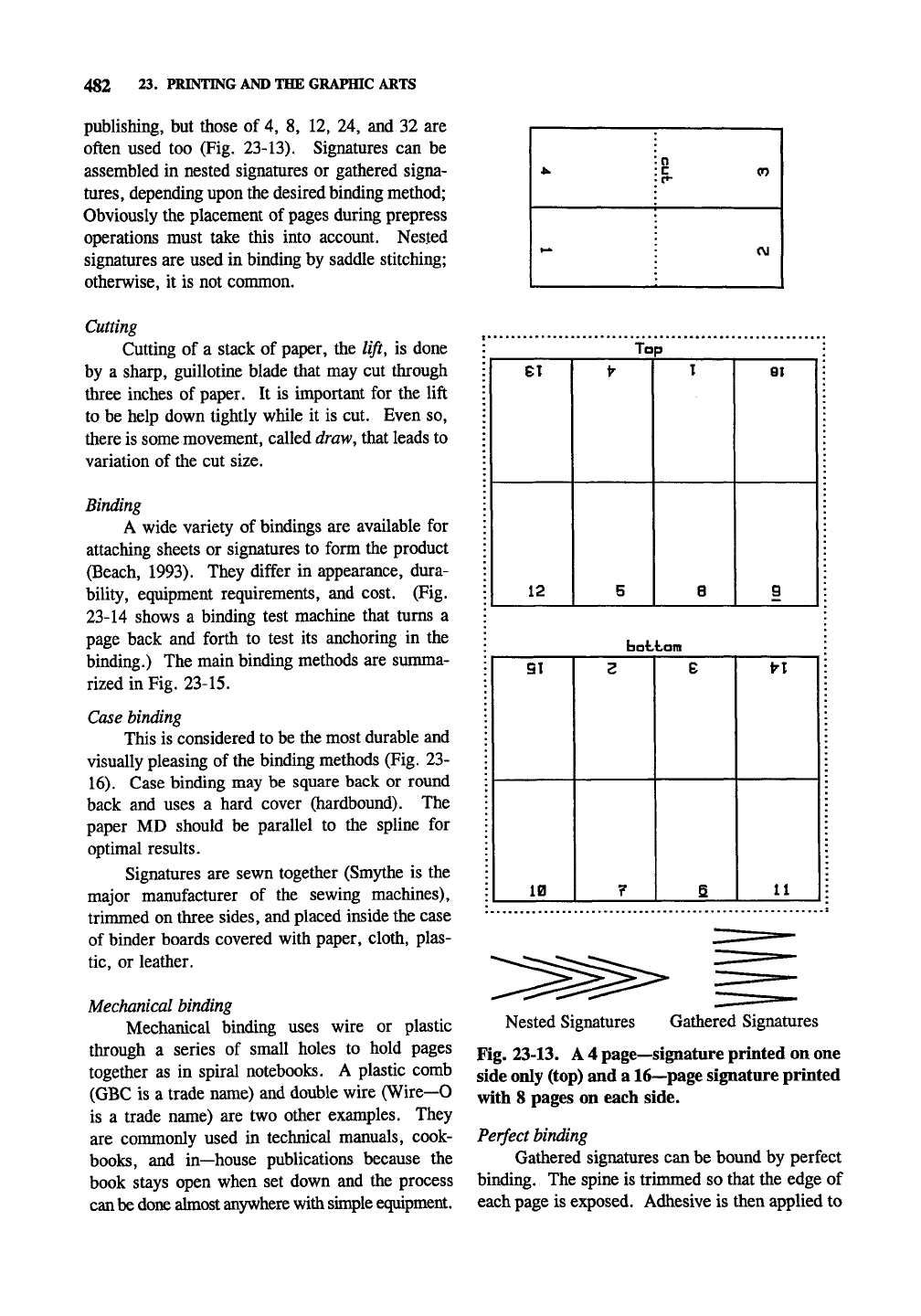
482 23. PRINTING AND THE GRAPHIC ARTS
publishing, but those of 4, 8, 12, 24, and 32 are
often used too (Fig. 23-13). Signatures can be
assembled in nested signatures or gathered signa-
tures,
depending upon the desired binding method;
Obviously the placement of pages during prepress
operations must take this into account. Nesjted
signatures are used in binding by saddle stitching;
otherwise, it is not common.
^
K*
5-
OJ
Cutting
Cutting of a stack of paper, the
lift,
is done
by a sharp, guillotine blade that may cut through
three inches of paper. It is important for the lift
to be help down tightly while it is cut. Even so,
there is some movement, called draw, that leads to
variation of the cut size.
Binding
A wide variety of bindings are available for
attaching sheets or signatures to form the product
(Beach, 1993). They differ in appearance, dura-
bility, equipment requirements, and cost. (Fig.
23-14 shows a binding test machine that turns a
page back and forth to test its anchoring in the
binding.) The main binding methods are summa-
rized in Fig. 23-15.
Case binding
This is considered to be the most durable and
visually pleasing of the binding methods (Fig. 23-
16).
Case binding may be square back or round
back and uses a hard cover (hardbound). The
paper MD should be parallel to the spline for
optimal results.
Signatures are sewn together (Smythe is the
major manufacturer of the sewing machines),
trimmed on three sides, and placed inside the case
of binder boards covered with paper, cloth, plas-
tic,
or leather.
Mechanical binding
Mechanical binding uses wire or plastic
through a series of small holes to hold pages
together as in spiral notebooks. A plastic comb
(GBC is a trade name) and double wire (Wire—O
is a trade name) are two other examples. They
are commonly used in technical manuals, cook-
books, and in—house publications because the
book stays open when set down and the process
can be done aknost anywhere with simple equipment.
Top
" ei
1 ^^
\r
5
I
8
9T
1
9
boLiom
\ ^^
1
10
2
7
e
s
\rl
1
11
Nested Signatures Gathered Signatures
Fig. 23-13. A 4 page—signature printed on one
side only (top) and a 16—page signature printed
with 8 pages on each side.
Perfect
binding
Gathered signatures can be bound by perfect
binding. The spine is trimmed so that the edge of
each page is exposed. Adhesive is then applied to
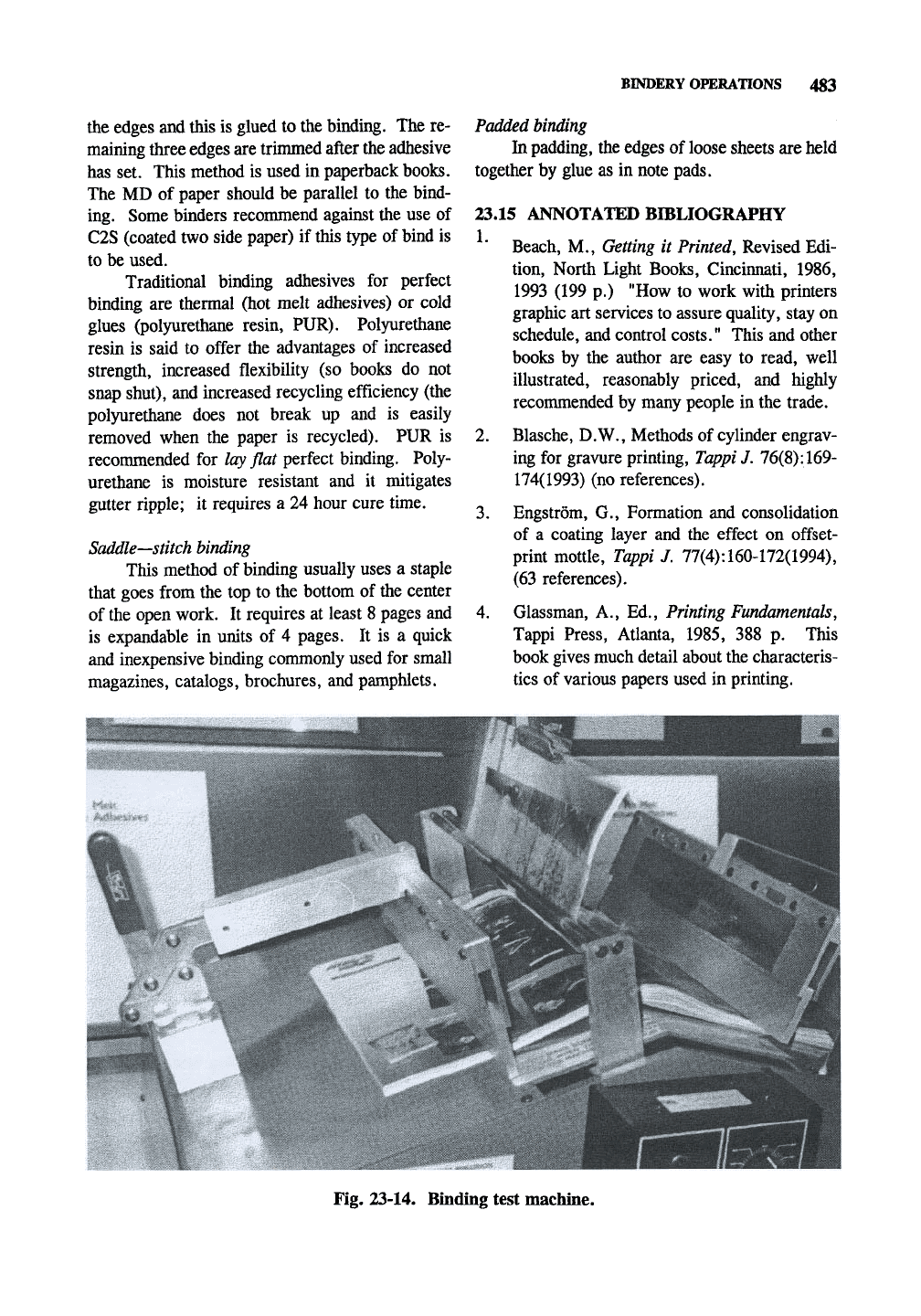
the edges and this is glued to the binding. The re-
maining three edges are trimmed after the adhesive
has set. This method is used in paperback books.
The MD of paper should be parallel to the bind-
ing. Some binders reconmiend against the use of
C2S (coated two side paper) if this type of bind is
to be used.
Traditional binding adhesives for perfect
binding are thermal (hot melt adhesives) or cold
glues (polyurethane resin, PUR). Polyurethane
resin is said to offer the advantages of increased
strength, increased flexibility (so books do not
snap shut), and increased recycling efficiency (the
polyurethane does not break up and is easily
removed when the paper is recycled). PUR is
recommended for
lay
flat perfect binding. Poly-
urethane is moisture resistant and it mitigates
gutter ripple; it requires a 24 hour cure time.
Saddle—stitch binding
This method of binding usually uses a staple
that goes from the top to the bottom of the center
of the open work. It requires at least 8 pages and
is expandable in units of 4 pages. It is a quick
and inexpensive binding commonly used for small
magazines, catalogs, brochures, and pamphlets.
BINDERY OPERATIONS 483
Padded
binding
In padding, the edges of loose sheets are held
together by glue as in note pads.
23.15 ANNOTATED BIBLIOGRAPHY
Beach, M., Getting it
Printed,
Revised Edi-
tion, North Light Books, Cincinnati, 1986,
1993 (199 p.) "How to work with printers
graphic art services to assure quality, stay on
schedule, and control costs." This and other
books by the author are easy to read, well
illustrated, reasonably priced, and highly
recommended by many people in the trade.
2.
Blasche, D.W., Methods of cylinder engrav-
ing for gravure printing, Tappi J.
76(8):
169-
174(1993) (no references).
3.
Engstrom, G., Formation and consolidation
of a coating layer and the effect on offset-
print mottle, Tappi J,
77(4):
160-172(1994),
(63 references).
4.
Glassman, A., Ed., Printing Fundamentals,
Tappi Press, Atlanta, 1985, 388 p. This
book gives much detail about the characteris-
tics of various papers used in printing.
Fig. 23-14. Binding test machine.
